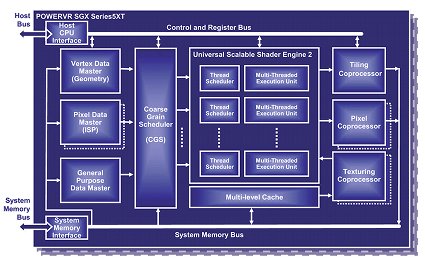Imagination revs graphics IP for mobile/embedded devices
Dec 6, 2010 — by LinuxDevices Staff — from the LinuxDevices Archive — 9 viewsImagination Technologies, a supplier of graphics IP to Intel as well as a variety of ARM licensees, announced a new version of its software. The company also said Renesas will use Imagination IP in a new SoC (system on chip), offering “levels of mobile and embedded graphics performance over five times that of the best current-generation devices.”
As we review later in this story, graphics IP from Imagination Technologies is a key element of processors from Apple, Freescale, Intel, NEC, Samsung, and TI. Today, Imagination announced the "latest member" of the Powervr SGX Series5XP IP it first announced in January.
According to the company, the new Powervr SGX554 IP can be implemented as a high-performance eight-pipe single core, or in multiprocessor (MP) configurations of between two and 16 cores (16 to 128 pipes). It provides "full support for DirectX 9 [link] Feature Level 3 with maximum hardware acceleration," the company says.
Imagination Technologies says its SGX544 IP will be "ideal for tablets, computing devices and smartphones." It delivers the industry's best metrics in terms of both performance per square millimeter and performance per milliwatt, the company adds.
It's said SGX554 also provides "comprehensive market-proven support" for desktop OpenGL 2.1 (including X11 integration with DRI2, EXA and DRM support), OpenGL ES 1.1 & 2.0, OpenVG 1.1, and OpenCL 1.1 Embedded Profile. Essentially the same claims were made in June for a previous SGX544 release, but that version was said to support a four-pipe single core or multiprocessor configurations with up to 64 pipes.
According to Imagination Technologies, Renesas has debuted a new SoC using Powervr SGX MP (multi-processor) graphics, delivering mobile and embedded graphics performance that's "over five times that of the best current generation devices." However, further information on the device has not yet appeared on the Renesas website.
Also announced by Imagination Technologies were the Powervr VXD392 decoder and Powervr VXE382 encoder, including support for H.264 MVC, WebM (VP8; decode), S3D (Stereoscopic 3D) and resolutions up to UltraHD. According to the company, these new codecs can integrate with various members of the Powervr SGX graphics IP family, enabling bitrate savings of approximately 2.5x compared to existing solutions.
Tony King-Smith, vice president of marketing for Imagination, stated, "These latest Powervr video decode and encode IP cores complement our industry-leading Powervr SGX graphics perfectly to create a total visual IP solution for our partners. Our VXD392 decoder core requires almost no system CPU and GPU processing resources, while … VXE382 brings our high quality encoding capabilities to the hot market area of stereoscopic 3D."
Imagination CEO Hossein Yassaie stated, "Customer demand for advanced graphics … is driving the required compute density of GPUs in mobile and embedded products on a dramatic upward path. Users will not settle for 'just good enough' graphics — they are actively choosing products that deliver the very best in UI, media, gaming and navigation. The new processor from Renesas will deliver the capabilities to drive mobile and embedded graphics devices to power the next level of graphics-rich user experiences."
Background
Imagination Technologies' Series5XT SGX IP is based on a second-generation Universal Scalable Shader Engine (USSE2), delivering "significantly better throughput" than the earlier Series5 USSE shader engine. It's said the architecture scales from 100MHz to 400MHz "and beyond," delivering performance of 35 million polygons per second and a pixel fill rate of one gigapixel per second when running at a mid-range 200MHz.

A block diagram of Imagination Technologies' Series5XT SGX IP
(Click to enlarge)
Backwards-compatible with the earlier Powervr MBX and SGX Series5, the Series5XT SGX IP supports "all industry standard mobile and desktop graphics APIs and operating sytems," according to Imagination Technologies. For example, it's said compatibility extends to Linux, Android, and Symbian, as well as Windows CE, Vista, and XP.
Prior to the June announcement of the SGX544, Powervr SGX Series5XT implementations included the two-core, four-pipeline SGX543, along with the 16-core, 64-pipeline SGX543MP2-16.
Commenting on the latter, Rik Myslewski wrote in a March article for The Register, "That's one hell of a lot of concurrent pixel and vertex shading." Because all data/pipeline/thread management is done in hardware, applications will be able to utilize any and all cores on a Series5XT SGX-based device without modification, he added.
Customers
Imagination Technologies — whose investors famously include both Apple and Intel — has seen its IP used in a bevy of x86 and ARM processors. In March, the company announced that more than 250 million devices had shipped with Powervr technology, including many in the mobile phone, media player, and embedded markets.
Citing a "multi-use license agreement" with TI, Imagination Technologies announced in May that the chipmaker will deploy the Powervr SGX Series5XT IP in future OMAP SoCs. Renesas, too, was set to "deploy the technology in future SoC designs for the mobile market," Imagination Technologies said at the time.
Further information
More information on Imagination Technologies' Powervr SGX Series5XT cores may be found here. Rik Myslewski's March article for The Register may be found here.
This article was originally published on LinuxDevices.com and has been donated to the open source community by QuinStreet Inc. Please visit LinuxToday.com for up-to-date news and articles about Linux and open source.